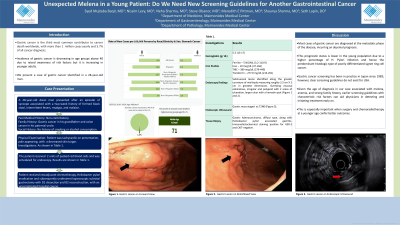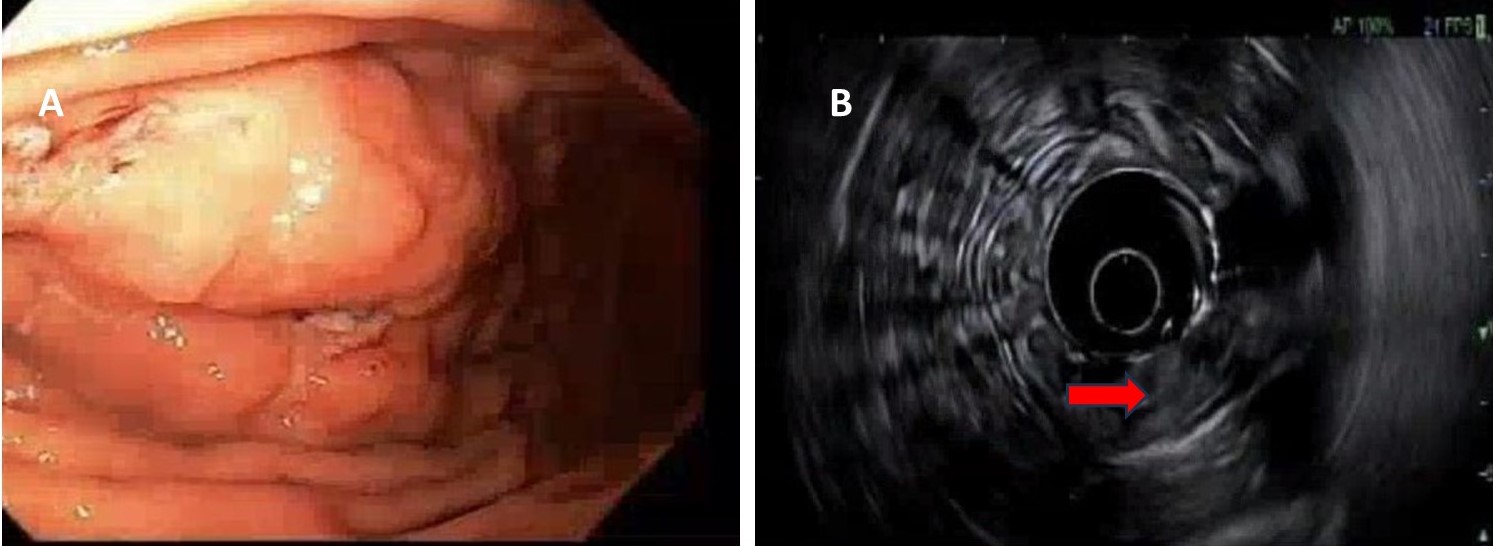Sunday Poster Session
Category: Stomach
P1664 - Unexpected Melena in a Young Patient - Do We Need Screening Guidelines for Another Gastrointestinal Cancer?
Sunday, October 27, 2024
3:30 PM - 7:00 PM ET
Location: Exhibit Hall E

Has Audio

Syed Mujtaba Baqir, MD
Maimonides Medical Center
Brooklyn, NY
Presenting Author(s)
Syed Mujtaba Baqir, MD, Nissim Levy, MD, Neha Sharma, MBBS, MD, Steve Obanor, MD, Meredith E. Pittman, MD, Shaurya Sharma, MD, Seth Lapin, DO
Maimonides Medical Center, Brooklyn, NY
Introduction: Gastric cancer is the third most common contributor to cancer death worldwide, with more than 1 million cases yearly and 5.7% of all cancer diagnoses. Where the incidence of gastric cancer is decreasing in age groups above 40 due to raised awareness of risk factors, it is increasing in younger adults. We present a case of gastric cancer identified in a 28-year-old male.
Case Description/Methods: A 28-year-old Asian man with no significant past medical history presented after an episode of syncope associated with a two-week history of formed black stool, intermittent fevers, myalgia, and malaise. His family history was significant for his grandfather's gastric cancer and his paternal uncle's colon cancer. The patient was tachycardic on presentation. On examination, he appeared to be pale with decreased skin turgor. Initial investigations revealed normocytic anemia with a hemoglobin of 5.5 g/dL (normal range 13-17g/dL) and a mean corpuscular volume of 87.5 fL (normal range 80-100 fL). CT scan of the abdomen and pelvis was unremarkable for any abdominal pathology. The patient was transfused with two packed red blood cells (PRBC) units. Esophagogastroduodenoscopy (EGD) revealed an approximately 2.5 cm lesion along the greater curvature of the stomach. Endoscopic ultrasound with biopsy staged it as T2N0. Biopsy results revealed gastric adenocarcinoma and Helicobacter pylori gastritis. The patient received neoadjuvant chemotherapy, Helicobacter Pylori eradication and underwent laparoscopic subtotal gastrectomy, with an uncomplicated post-operative period.
Discussion: Most cases of gastric cancer are diagnosed at the metastatic phase of the disease, incurring as low as a 5-year survival rate and hence an abysmal prognosis. This prognostic status is lower in the young population due to a higher percentage of H. Pylori infection and hence the predominant histologic type of poorly differentiated signet ring cell cancer – coupled with lack of known early preventative measures. Gastric cancer screening has been in practice in Japan since 1983; however, clear screening guidelines do not exist for gastric cancer in the United States of America (USA). Given the age of diagnosis in our case associated with melena, anemia, and strong family history, earlier screening guidelines with characteristic risk factors can aid physicians in detecting and initiating treatment early on. This is especially important when surgery and chemoradiotherapy at a younger age confer better outcomes.

Disclosures:
Syed Mujtaba Baqir, MD, Nissim Levy, MD, Neha Sharma, MBBS, MD, Steve Obanor, MD, Meredith E. Pittman, MD, Shaurya Sharma, MD, Seth Lapin, DO. P1664 - Unexpected Melena in a Young Patient - Do We Need Screening Guidelines for Another Gastrointestinal Cancer?, ACG 2024 Annual Scientific Meeting Abstracts. Philadelphia, PA: American College of Gastroenterology.
Maimonides Medical Center, Brooklyn, NY
Introduction: Gastric cancer is the third most common contributor to cancer death worldwide, with more than 1 million cases yearly and 5.7% of all cancer diagnoses. Where the incidence of gastric cancer is decreasing in age groups above 40 due to raised awareness of risk factors, it is increasing in younger adults. We present a case of gastric cancer identified in a 28-year-old male.
Case Description/Methods: A 28-year-old Asian man with no significant past medical history presented after an episode of syncope associated with a two-week history of formed black stool, intermittent fevers, myalgia, and malaise. His family history was significant for his grandfather's gastric cancer and his paternal uncle's colon cancer. The patient was tachycardic on presentation. On examination, he appeared to be pale with decreased skin turgor. Initial investigations revealed normocytic anemia with a hemoglobin of 5.5 g/dL (normal range 13-17g/dL) and a mean corpuscular volume of 87.5 fL (normal range 80-100 fL). CT scan of the abdomen and pelvis was unremarkable for any abdominal pathology. The patient was transfused with two packed red blood cells (PRBC) units. Esophagogastroduodenoscopy (EGD) revealed an approximately 2.5 cm lesion along the greater curvature of the stomach. Endoscopic ultrasound with biopsy staged it as T2N0. Biopsy results revealed gastric adenocarcinoma and Helicobacter pylori gastritis. The patient received neoadjuvant chemotherapy, Helicobacter Pylori eradication and underwent laparoscopic subtotal gastrectomy, with an uncomplicated post-operative period.
Discussion: Most cases of gastric cancer are diagnosed at the metastatic phase of the disease, incurring as low as a 5-year survival rate and hence an abysmal prognosis. This prognostic status is lower in the young population due to a higher percentage of H. Pylori infection and hence the predominant histologic type of poorly differentiated signet ring cell cancer – coupled with lack of known early preventative measures. Gastric cancer screening has been in practice in Japan since 1983; however, clear screening guidelines do not exist for gastric cancer in the United States of America (USA). Given the age of diagnosis in our case associated with melena, anemia, and strong family history, earlier screening guidelines with characteristic risk factors can aid physicians in detecting and initiating treatment early on. This is especially important when surgery and chemoradiotherapy at a younger age confer better outcomes.

Figure: Gastric lesion on forward view of endoscope (A) and on endoscopic ultrasound (B)
Disclosures:
Syed Mujtaba Baqir indicated no relevant financial relationships.
Nissim Levy indicated no relevant financial relationships.
Neha Sharma indicated no relevant financial relationships.
Steve Obanor indicated no relevant financial relationships.
Meredith Pittman indicated no relevant financial relationships.
Shaurya Sharma indicated no relevant financial relationships.
Seth Lapin indicated no relevant financial relationships.
Syed Mujtaba Baqir, MD, Nissim Levy, MD, Neha Sharma, MBBS, MD, Steve Obanor, MD, Meredith E. Pittman, MD, Shaurya Sharma, MD, Seth Lapin, DO. P1664 - Unexpected Melena in a Young Patient - Do We Need Screening Guidelines for Another Gastrointestinal Cancer?, ACG 2024 Annual Scientific Meeting Abstracts. Philadelphia, PA: American College of Gastroenterology.
